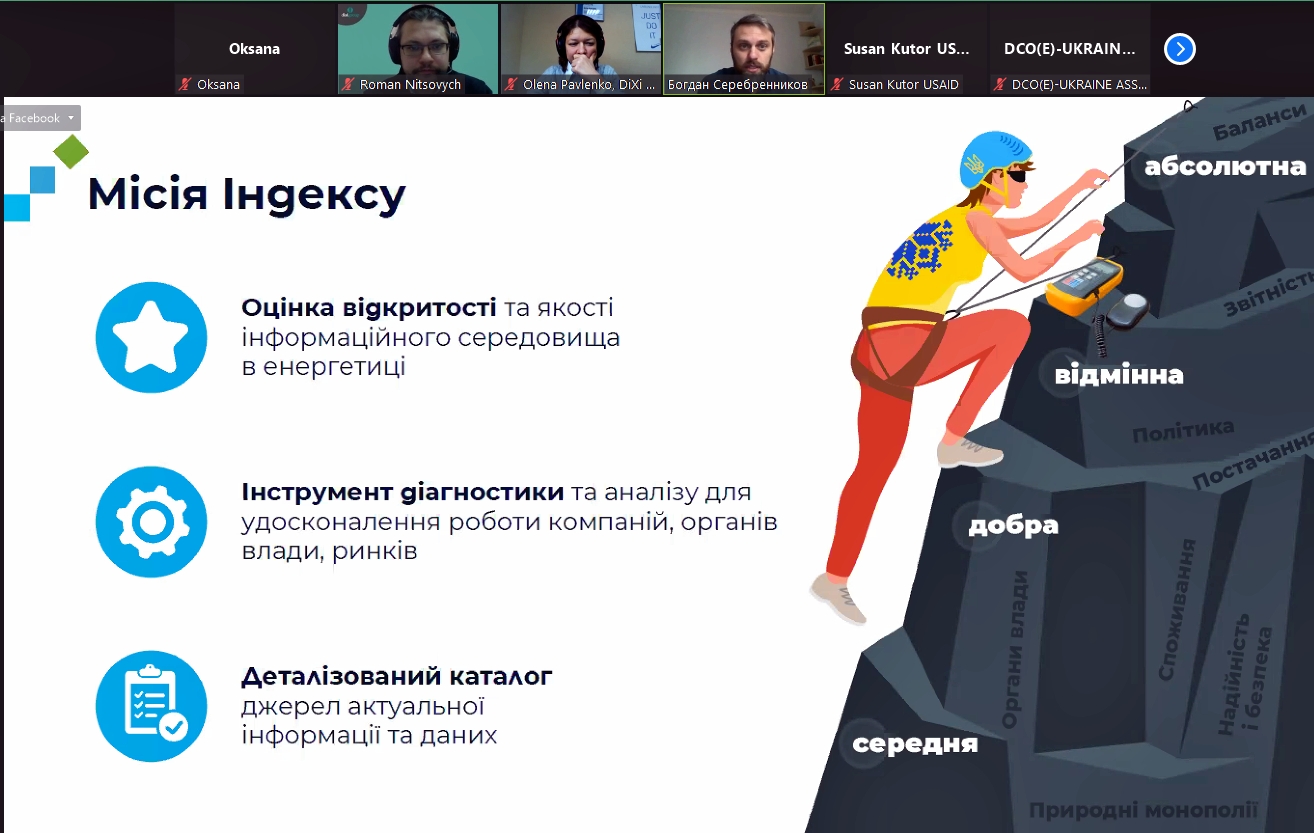Energy Transparency Index of Ukraine 2021: information openness is growing
Transparency in the energy sector continues to improve compared to previous years, but the pace of growth has slowed down. This is the conclusion reached by experts who worked on the study

“USAID pays special attention to sector transparency and the competitiveness of energy markets, and supports DiXi Group’s annual efforts,” said USAID Deputy Mission Director Susan Kutor at the beginning of the presentation of the Index’s results. As we know, openness of data builds trust between consumers, market participants and regulators, develops competition and investment. In turn, it predetermines better service, competitive pricing for consumers, and reduces opportunities for corruption. “We believe that transparency and accountability are the foundation on which the further process of reforming Ukraine’s energy sector should be built,” said Susan Kutor. “Energy Transparency Index of Ukraine 2021 plays an important role in assuring whether Ukrainian reforms have a solid evidence base.”
The Energy Transparency Index has been developed to assess the real state of availability and quality of information in the energy sector and to diagnose gaps. DiXi Group has been analyzing the transparency of the energy sector since 2018 (see video).
“This is our fourth issue of the Index. Now we can track the openness of energy sectors in dynamics and make conclusions, whether the government and companies are increasing their transparency and accountability, or, on the contrary, are closing from society every year, and where exactly it happens,” said Olena Pavlenko, President of DiXi Group, during the presentation. “We used to think that the Index would be most needed by the government to understand how to prioritize reforms. Now we see that the results of the sector openness analysis are used not only by the authorities, but also by donors, international partners, companies, and NGOs. And not only in Ukraine, but also in other countries. Probably, one day the Index will become one of the tools for the World Bank, IMF or OECD to assess the reforms in the countries they work with. The Transparency Index is gradually becoming international. We have adapted its methodology to the EU and the Eastern Partnership countries.
This year, the Index covers 212 indicators grouped into 8 categories. The 2021 Index is supplemented by three new indicators based on the provisions of the Clean Energy Package, the current framework rules for energy markets in the EU. Evaluation is the result of open source data processing.
Ukraine’s final score according to evaluation in 2021 is 63 out of 100 possible, indicating average transparency in the energy sector. At the same time, compared to last year’s evaluation, transparency in most categories has increased, and the Index itself has increased by 5 points.
See more results – https://index.ua-energy.org/en/
Last year, during the presentation of results of the study, experts noted the acceleration of progress. This year, the pace of growth has slowed down compared to last year (5 vs 10 points).
“If we move at a pace of + 5 points, it will still take several years to get to the zone of good transparency,” said Bohdan Serebrennikov, Senior Analyst at DiXi Group and Project Manager, during the presentation of the results of the work. “We also saw regress in the “Politics” category. Positive changes are traditionally absent only in the “Balances” category in terms of publishing energy statistics.
It is especially worth noting that for the first time in four years the Index recorded a zone of good transparency in two categories. In particular, the greatest progress is observed in “Reporting” and “Natural Monopolies” categories (+ 18 and + 11 points, respectively).
See more results – https://index.ua-energy.org/en/
“Black boxes are indicators for which information is completely missing. Their number is decreasing,” said Bohdan Serebrennikov. “If in 2019 they represented 24%, in 2020 – 20%, then this year they represent 16%. We continue to disclose information, and we hope that the Index contributes to this trend. “
A comparison of markets showed that there has been steady progress and two markets have also reached the zone of good transparency for the first time, namely natural gas and electricity markets.
According to the researchers, the transparency here is conditioned by the regulatory framework and the level of regulation. For example, the sector’s transparency began to grow faster after new rules for the electricity market were introduced in 2020. The current evaluation showed tangible progress in both markets – Electricity (+7 points) and Natural Gas (+8 points), which moved from medium to good transparency.
As for the Oil and Liquid Fuel sector, the development of which the state pays much less attention to, its transparency remains unsatisfactory (23 points). This was noted during the presentation by Hennadii Riabtsev, Professor at Kyiv-Mohyla School of Government, project expert. Particular attention should be paid to ensuring the independence of transmission system operators, increasing the transparency of wholesale and retail energy market participants, as well as operators of transmission, storage and distribution systems in the Oil and Liquid Fuel sector. State regulation of prices in the electricity and gas markets also needs greater transparency, in terms of setting regulated prices for the population, marginal prices in wholesale markets, etc.
Positive changes are not happening fast enough in informing about reliability and security of supply, in balance sheet annual and, especially, monthly statistics, and in energy efficiency issues.
“If we talk about the convenience of work, there is a big request to the Ministry of Energy to resume the publication of information on stocks in the warehouses of CHPPs and TPPs in a format that is suitable for data analysis,” said Hennadii Riabtsev. “It’s unfortunate to say when something gets worse from what was good and was perceived as an achievement last year.”
Comparison with previous evaluations shows an improvement in transparency in the subcategory “Metering Devices” (f70 vs 80 points), in particular due to the disclosure of data on the status of providing the consumers with smart metering devices. At the same time, for the subcategory “Service Standards” the score dropped from 100 to 83 points, primarily due to incomplete information on the quality of natural gas supply, said Uliana Pysmenna, lecturer and author of scientific monographs on energy markets and energy efficiency, project expert.
At the same time, the improved work of Energy Online mobile application and Gasoteka price comparison service developed with the support of USAID in cooperation with NEPURC demonstrates the potential and need to develop digital applications and online services to compare commercial offers and generalize the price situation in Ukraine’s energy markets.
Compared to last year, transparency for the Reporting category has increased from 35 to 53 points. Although the increase was somewhat influenced by the renewal of the samples, which included four companies that adhere to the requirements of transparency, such an improvement was due to qualitative changes, said Dmytro Naumenko, Senior Analyst at the Ukrainian Centre for European Policy, project expert.
In the Index 2021, experts continued to analyze the authorities that formulate and implement policies in the energy sector and related areas. Compared to last year’s pilot evaluation, only one of the six authorities (the AMCU) remained in the zone of insufficient transparency, while two others (the Ministry of Energy and the State Statistics Service) moved into the zone of medium transparency. The State Agency on Energy Efficiency and Energy Saving has also shown progress and moved into the zone of good transparency, where, as last year, the Regulator (NEPURC) and the Ministry of Environment are located.
According to researchers, the estimates of the Index by the authorities should be perceived not as a rating, but as an indicator and incentive for improvement. In particular, the lack of information and shortcomings of its presentation revealed during the evaluation are the basis for specific recommendations to authorities and companies, which are set out at the end of each section of the study.
Detailed information on the Index, tables of indicators with estimates and comparative graphs by years can be found on the page of Transparency Index – https://index.ua-energy.org/en/










